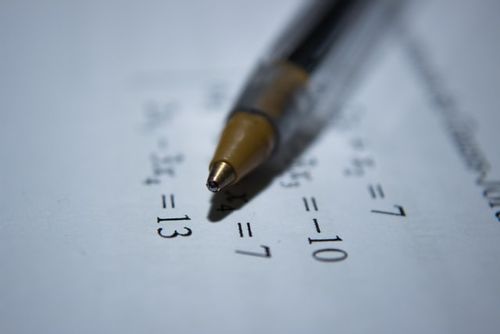FOR AGES 7 YEARS TO 11 YEARS
Image © Alexas_Fotos, under a Creative Commons license.
Take a look at a watch or clock - what symbols are there to represent the numbers that you use to tell the time?
If you see the symbols I to XII, then you are using Roman numerals to tell the time. But where are the Roman numerals used elsewhere in everyday life?
As your Year 3, Year 4, Year 5 or Year 6 child comes bounding home from school with plenty of questions, you get yourself up to speed and armed with answers using our quick and easy cheat sheet.
As the name suggests, Roman numerals were used in ancient Rome. They are made up of letters that were taken from the Latin alphabet and were used to represent numbers. It's thought Roman numbers were the only written number system until about 900 AD, when Arabic numbers came into use. These are the numbers we use today.

Image © analogicus, under a Creative Commons license.
If you find yourself helping your child with their KS2 homework, here's a quick guide on how to read Roman numerals.
1 = I
2 = II
3 = III
4 = IV
5 = V
6 = VI
7 = VII
8 = VIII
9 = IX
10 = X
20 = XX
30 = XXX
40 = XL
50 = L
60 = LX
70 = LXX
80 = LXXX
90 = XC
100 = C
500 = D
1000 = M
2000 = MM
As you can see from the list above, there are only seven symbols to learn (I, V, X, L, C, D and M) which are then applied in various combinations to make the numbers. For example, as I represents 1, III is 3 because it is I + I + I.
It is important to note that the same four numerals are never used in a row. Instead, a subtraction method is used. If you see a symbol that represents less than the numeral after it, you take that first numeral away from the second. For example, 4 is IV because it is 5-1, and 90 is XC because it is 100-10.

Image © eyeofpaul, under a Creative Commons license.
Children will learn Roman numerals across KS2. In Year 3, children will learn how to write and tell the time on a Roman clock. In Year 4, they will learn to read 1 to 100 (I to C) and in Year 5 they will read the Romans' numbers up to 1,000 (M) and recognise how years are written in Roman numerals.
Roman numerals are still used today because they are a great way to combine maths and history. Their most common use today is on a clock face, representing the numbers 1 to 12. However, they are also regularly used in a couple of other ways.
Years: The year 2020 in Roman numerals is written MMXX. (This is often seen in the end credits of a television programme)
Rulers: Roman numerals are commonly used in the titles of monarchs (for example, King Henry VIII and Queen Elizabeth II) or religious leaders (such as Pope Benedict XVI).

Image © khromkrathok, under a Creative Commons license.
Roman numerals are a great way to introduce algebra skills to kids. Here are some easy ways to get children of all school years learning and talking about the topic:
1) If you've got an old watch with the numerals on its face, see if you can alter the strap so it fits on your child's wrist. That way they'll be practising and getting used to the system quickly without even realising it, simply by telling the time.
2) Encourage your child to decipher Roman numerals at the end of their favourite TV show (yes, they are used on CBBC programmes!), or in books where they are often used to show their publication date.
3) When children use numbers in everyday life, you could ask them what that number is in Roman numerals. So, when they ask for three breadsticks, ask them to tell you what that would be in Roman numerals before giving them the snack.
4) If you've got a bit of time together, create a bingo card which has the numerals on instead of traditional numbers. Then you can play the bingo caller and ask your child to cross off the numbers as you read them out.
5) If you're playing board games on a rainy day, why not covering up a one to six dice with the I to VI symbols?
Read The Disclaimer
At Kidadl we pride ourselves on offering families original ideas to make the most of time spent together at home or out and about, wherever you are in the world. We strive to recommend the very best things that are suggested by our community and are things we would do ourselves - our aim is to be the trusted friend to parents.
We try our very best, but cannot guarantee perfection. We will always aim to give you accurate information at the date of publication - however, information does change, so it’s important you do your own research, double-check and make the decision that is right for your family.
Kidadl provides inspiration to entertain and educate your children. We recognise that not all activities and ideas are appropriate and suitable for all children and families or in all circumstances. Our recommended activities are based on age but these are a guide. We recommend that these ideas are used as inspiration, that ideas are undertaken with appropriate adult supervision, and that each adult uses their own discretion and knowledge of their children to consider the safety and suitability.
Kidadl cannot accept liability for the execution of these ideas, and parental supervision is advised at all times, as safety is paramount. Anyone using the information provided by Kidadl does so at their own risk and we can not accept liability if things go wrong.
Kidadl is independent and to make our service free to you the reader we are supported by advertising.
We hope you love our recommendations for products and services! What we suggest is selected independently by the Kidadl team. If you purchase using the buy now button we may earn a small commission. This does not influence our choices. Please note: prices are correct and items are available at the time the article was published.
Kidadl has a number of affiliate partners that we work with including Amazon. Please note that Kidadl is a participant in the Amazon Services LLC Associates Program, an affiliate advertising program designed to provide a means for sites to earn advertising fees by advertising and linking to amazon.
We also link to other websites, but are not responsible for their content.
Was this article helpful?



Browse Category



We’ll send you tons of inspiration to help you find a hidden gem in your local area or plan a big day out.



Check your inbox for your latest news from us. You have subscribed to:
Remember that you can always manage your preferences or unsubscribe through the link at the foot of each newsletter.